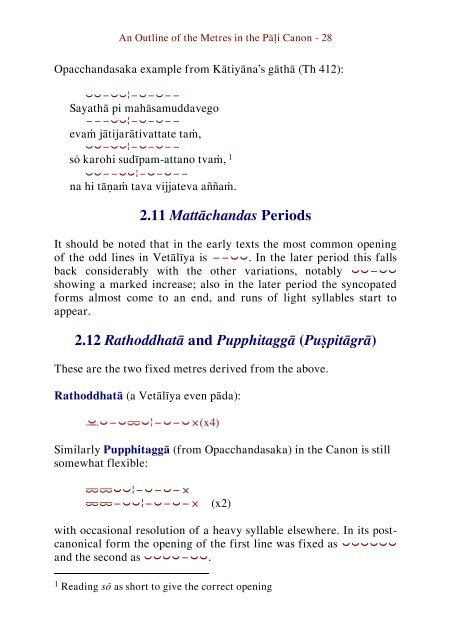An Outline of the Metres in the Pāḷi Canon
A concise but thorough explanation of the metres that are found in the Pāli canon, along with examples and glossary.
A concise but thorough explanation of the metres that are found in the Pāli canon, along with examples and glossary.
Create successful ePaper yourself
Turn your PDF publications into a flip-book with our unique Google optimized e-Paper software.
<strong>An</strong> <strong>Outl<strong>in</strong>e</strong> <strong>of</strong> <strong>the</strong> <strong>Metres</strong> <strong>in</strong> <strong>the</strong> <strong>Pāḷi</strong> <strong>Canon</strong> - 28<br />
Opacchandasaka example from Kātiyāna’s gāthā (Th 412):<br />
⏑⏑−⏑⏑¦−⏑−⏑−−<br />
Sayathā pi mahāsamuddavego<br />
−−−⏑⏑¦−⏑−⏑−−<br />
evaṁ jātijarātivattate taṁ,<br />
⏑⏑−⏑⏑¦−⏑−⏑−−<br />
sŏ karohi sudīpam-attano tvaṁ, 1<br />
⏑⏑−−⏑⏑¦−⏑−⏑−−<br />
na hi tāṇaṁ tava vijjateva aññaṁ.<br />
2.11 Mattāchandas Periods<br />
It should be noted that <strong>in</strong> <strong>the</strong> early texts <strong>the</strong> most common open<strong>in</strong>g<br />
<strong>of</strong> <strong>the</strong> odd l<strong>in</strong>es <strong>in</strong> Vetālīya is −−⏑⏑. In <strong>the</strong> later period this falls<br />
back considerably with <strong>the</strong> o<strong>the</strong>r variations, notably ⏑⏑−⏑⏑<br />
show<strong>in</strong>g a marked <strong>in</strong>crease; also <strong>in</strong> <strong>the</strong> later period <strong>the</strong> syncopated<br />
forms almost come to an end, and runs <strong>of</strong> light syllables start to<br />
appear.<br />
2.12 Rathoddhatā and Pupphitaggā (Puṣpitāgrā)<br />
These are <strong>the</strong> two fixed metres derived from <strong>the</strong> above.<br />
Rathoddhatā (a Vetālīya even pāda):<br />
Similarly Pupphitaggā (from Opacchandasaka) <strong>in</strong> <strong>the</strong> <strong>Canon</strong> is still<br />
somewhat flexible:<br />
⏔⏔⏑⏑¦−⏑−⏑−×<br />
⏔⏔−⏑⏑¦−⏑−⏑−×<br />
(x2)<br />
with occasional resolution <strong>of</strong> a heavy syllable elsewhere. In its postcanonical<br />
form <strong>the</strong> open<strong>in</strong>g <strong>of</strong> <strong>the</strong> first l<strong>in</strong>e was fixed as ⏑⏑⏑⏑⏑⏑<br />
and <strong>the</strong> second as ⏑⏑⏑⏑−⏑⏑.<br />
1 Read<strong>in</strong>g sŏ as short to give <strong>the</strong> correct open<strong>in</strong>g

















